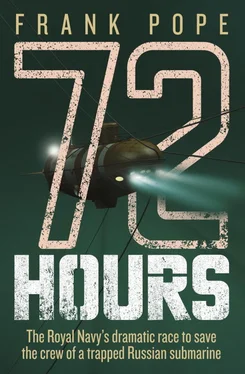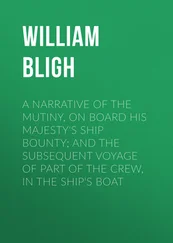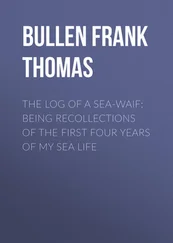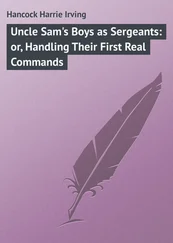Macintyre paused for a second as if waiting for a punch-line. None came. ‘Er… no, I’m sorry, I’m going to need those weights accurate to the last, well, more or less to the last pound,’ he said. ‘We’re going to need every drop of fuel we can get on board. The last thing we want to do is run out.’
Now it was Gold’s turn to pause in disbelief. But Macintyre was serious. The 4,500-mile run to Kamchatka was at the outer edge of the C17’s range. To calculate how much jet-A1 fuel they could load, they needed to know how much the submarine rescue system weighed.
‘I’ll get on it,’ said Gold, and hurried off to the command container. He should have seen that request coming. Both Scorpio and LR5 were designed to be air-transportable – in fact they were lighter than the rescue systems of many other countries, making this was one of the major advantages of the UK system. But aside from one trip to Sweden in an Antonov a few years back, all the exercises had involved loading the system straight on to a mother ship from a lorry, so he’d forgotten just how exact the requirements were.
He pulled out the data file and ran through the weights. All had been taken within the last year, and no major modifications had been done since then. Just to be sure, he compared notes with the crane driver that Prestwick airport had supplied upon their arrival. While picking each of the containers off the flatbeds, the driver had taken down the readings on the crane’s strain gauges. The figures tallied, so Gold passed them on to Macintyre.
The loadmaster passed on the total weight to the co-pilot for the fuel calculations, and moved on to the next phase of his job: to work out where on the plane he should load each of the pieces of kit. When flying fully loaded, the enormous C17 needed its centre of gravity in exactly the correct spot. If the cargo was placed too far forward the nose would never lift off the ground. Too far back and the freighter would take off only to stall and fall back to earth. It was the loadmaster’s job to make sure everything was secured in exactly the right place in the cargo bay.
Most of the equipment being carried out to the UK’s overseas campaigns had been air-freighted before, and even then it was not taken at such short notice. At Brize Norton the Joint Air Transport Evaluation unit had a full-size mock-up of the C17’s cargo bay where all cargoes could be accurately weighed and their ideal load position worked out. All the loadmaster usually had to do was to follow the instructions and plug the resulting figures into the on-board Michigan computer. Supplied with the weights and their position in the cargo bay, the computer gave the final confirmation that the aircraft would fly.
But they’d never loaded this equipment before, and Macintyre and the other loadmaster found themselves beginning a high-pressure test of their training. Word had spread fast that this was no exercise, and that Russian sailors were trapped beneath a freezing sea on the other side of the world, hours away from dying, and that these containers might hold the key to their survival. The growing fleet of press vans only added to the tension. The newshounds had been kept well away, just inside the perimeter fence, but it was obvious that cameras were already rolling. The loadmasters tried to keep such things out of their mind, concentrating on getting each container in the right way around (their internal weight distribution mattered, too) and then shifting it left a couple of inches, right a bit, back or forward until it was in exactly the right place. What with all the effort going into loading the aircraft, the process of unloading it again seemed a distant concern.
They were not privy to the ongoing conversation on the ISMERLO website, where it had emerged that Petropavlovsk airfield did not have the capability to offload either the US or the UK’s equipment. Neither team had room for the requisite K loader inside their aircraft, so the Naval attachés began to request that the equipment be sourced in Russia and waiting for them there on arrival. A rolling teleconference was established by ISMERLO to resolve the issue, along with a steadily mounting number of others.
As the loadmasters were worrying about how to load the rescue kit while keeping the C17’s centre of gravity in the right place, Hewitt and his co-pilot were trying to work out if they could actually make it all the way to Kamchatka with the fuel they were able to carry. Stopping to refuel would cost them valuable hours, hours that Russian officials had tacitly admitted they didn’t have. But it would help no one for the UK’s rescue effort to make it nine-tenths of the way to the incident site and then run out of fuel.
The C17’s maximum take-off weight was 585,000 pounds – around 260 tons. The rescue equipment wasn’t that heavy, compared to the tanks and artillery they sometimes carried, so much of their payload could be fuel, which would burn off as the journey progressed. The jet plan would have to juggle the greater efficiency of flying high with the fuel cost of getting up there – a decision whose crucial factor was the strength and direction of the winds. They’d be flying the path of the polar jet stream, where winds could vary between 52 and 215 knots. For that reason, today’s jet plan for the route could be very different from tomorrow’s.
Flying at the extreme edge of an aircraft’s capability presented other problems too. Weather forecasts were wrong only slightly less often than they were right, and on a long-haul flight such forecasting errors could mean hours being added to the journey time – airborne hours that an aircraft with just enough fuel might not be able to afford. Such uncertainty – together with the risk of equipment malfunction – made planning good diversions an integral part of flight planning.
The unfamiliarity of the territory only made things worse. Not only had Hewitt never flown over any of this territory before, but the most detailed charts anyone could find were 1:1,000,000 – 50 times less accurate than they would normally use. On this chart, 50 centimetres got you halfway around the world. Hewitt tried various combinations as a backup airfield, but he was continually coming up short. The enormous swathe of eastern Russia was barren of airfields, at least on that chart. He couldn’t find a route to Kamchatka that would give a workable diversion. Without one, if the wind blew even slightly in the wrong direction, the C17 – and its 29 crew and passengers – would create an emergency much worse than the one they were trying to resolve.
Friday, 5 August/Saturday, 6 August
SS + 36 h 45 mins
17.15 UK – 20.15 Moscow – 05.15 Kamchatka
Prestwick International Airport, Glasgow
Just over an hour after leaving Filton, the Nimrod turned on to final approach for Prestwick airport. Riches peered through the cockpit windows trying to spot where his team had congregated, then finally saw the enormous grey bulk of the C17. The white tubes of the airliners nearby looked like twigs next to a tree trunk. The thing was huge.
After touch-down the Nimrod rumbled down interminable taxiways until suddenly the C17 appeared again, its bulk filling the view. During the isolation of the flight, Riches had been convincing himself that the crisis would suddenly have been solved or his team stood down, but crews were bustling all around the aircraft.
Two hundred metres away the Nimrod rolled to a halt and airport steps were brought up to the door. A crewman opened it to reveal a red van at the bottom of the steps, with two men in suits standing alongside.
Riches took his bag off the crewman, walked down the stairs and shook their hands.
‘Kind of you to offer a lift, but I’ll walk it,’ he said.
Читать дальше












